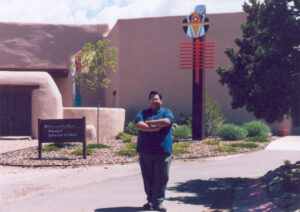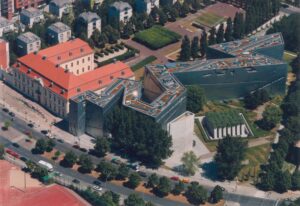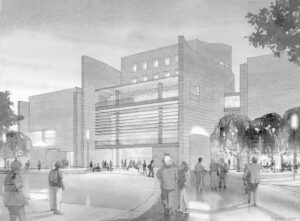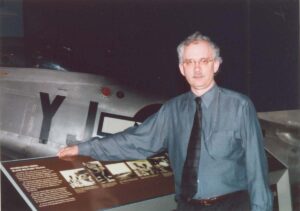SUITLAND, Md. — The George family traveled to the nation’s capital from their northern California reservation this July with a clear agenda: To inform America about the Hupas’ continuing battle to preserve their land and culture against environmental threats.
“America has been educated from a colonial, oppressive perspective, and then [Walt] Disney has come along and colored who we are,” said Laura Lee George, an assistant school superintendent whose husband, Merv George Sr., is the tribe’s ceremonial leader. George said she hoped the Smithsonian Institution’s National Museum of the American Indian (NMAI) – which footed the bill for the trip—would help alter those images.
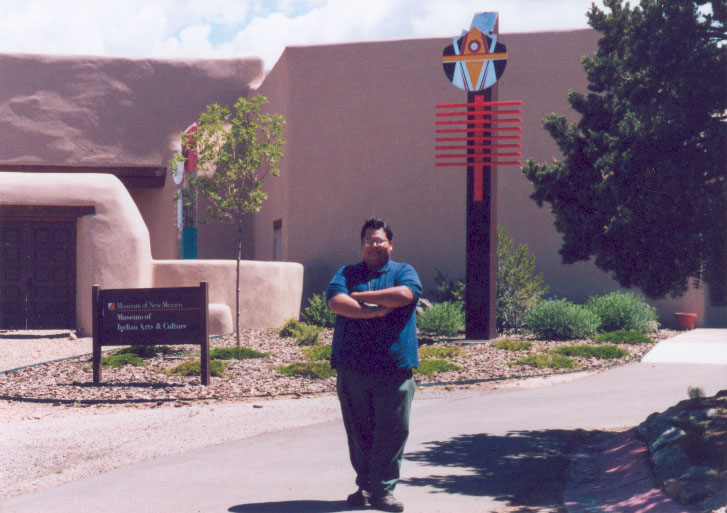
Emil Her Many Horses, the Oglala Sioux curator of the museum’s “Our Universes” exhibition, and Bruce Bernstein, the museum’s assistant director for cultural resources, had their own agenda for the George family. Aided by Hupa activist and scholar David Risling, the Georges were to select and discuss Hupa baskets, ceremonial garments and other artifacts from the museum’s 800,000-object Heye Collection for a gallery on the tribe’s cosmology.
There was one possible sticking point: Some of the information the museum sought is considered so sacred by the Hupas it cannot be made public. “We’re trying to figure out how much we want to share – even with the Smithsonian,” Merv George Jr., the former tribal chairman, explained at a breakfast reception at the museum’s Cultural Resources Center here. “They have these items. But they don’t have the stories that go along with the items…We’re privately caucusing, saying, ‘How much do we want to put into this?’ ” He added: “We’re here for them. But, by the same token, we’re not selling ourselves out.”
In Santa Fe, N.M., Tony Chavarria, the museum’s liaison with the Santa Clara Pueblos, said his people were wrestling with the same issue. “What I think is that, for NMAI, cosmology is a code word for religion,” said Chavarria. But, for Pueblos, religion is “very personal, private, internal.” Whatever museum visitors learn about Santa Clara cosmology, he said, it won’t be the full story.
The 1989 creation of the National Museum of the American Indian—by federal legislation and with a planned mix of federal and private money – was a significant cultural milestone, marking an unusual collaboration between the U.S. government and Native American tribes.
Now, with its $110 million centerpiece building due to open on the National Mall in 2003, the museum is wrestling quietly with a new set of challenges, stemming from the sensitivity of its mission and the potential cultural divide between Indian folkways and tourist expectations.
Fears about how this chasm might be bridged already have led to clashes between exhibition developers and curators, along with the departure of at least one high-ranking curator. “Was there anxiety? Yes, there was,” said James Volkert, the museum’s assistant director for exhibitions and public spaces. “I think the anxiety came, in some ways, from the unknown.” Volkert said his department has since backed off and slowed down the design process to alleviate internal tensions.
The NMAI’s history so far, under the leadership of founding director W. Richard West, has combined successes with setbacks. In 1994, the museum opened its first showcase, the George Gustav Heye Center, at the Beaux Arts-style Alexander Hamilton U.S. Custom House in lower Manhattan. Four years later, after a messy contractual dispute, it fired its design architect for the Mall museum, Douglas Cardinal, a Canadian of Blackfoot descent. The brouhaha provoked a lawsuit (since settled), earned the Smithsonian a critical thrashing in the Washington Post, and delayed needed architectural approvals. Cardinal remains bitter to this day.
But 1999 was a good year for the museum. It began operations at the Cultural Resources Center, where the bulk of the magnificent collection amassed by Heye (1874-1957) is being transferred from storage in New York. It also hosted an emotional groundbreaking at the Mall, complete with Native American blessings.
West, a Harvard and Stanford-educated lawyer who is Southern Cheyenne, said that one of his first principles is “the wish to invoke the Native voice” in designing the museum. The museum board, by statute, has a Native American majority, and the institution is pledged to “incorporate indigenous methodologies for conservation, documentation and collections care.” Its statement of goals recognizes the issue broached by the Hupas, Pueblos and others by promising to “acknowledge and respect that some indigenous communities have restricted cultural knowledge.” After his Washington visit, Merv George Jr. reported that “the [NMAI] staff was very polite and understanding of all the sensitive issues surrounding the Hupa culture.”
But, even as it seeks to accommodate its Indian constituencies, the museum’s toughest task will remain that of translation. As Calvin Martin argues in The American Indian and the Problem of History, the Native American concept of time is cyclical, with history based on an oral tradition of storytelling. And Native views of their interaction with Europeans remain at odds with what has been taught in most American classrooms. To succeed, the National Museum of the American Indian must transform Native American ideas and objects into exhibitions and programs that are accessible, unthreatening, but also provocative to a largely non-Native audience.
So far, the Washington museum has specified that it will involve some 34 tribes in developing three core exhibitions called “Our Universes,” on Native philosophies; “Our Peoples,” on Native histories; and “Our Lives,” on Native identities. It will draw not only on the Heye Collection, but also on newly purchased contemporary artworks. In-house curators will provide a connective tissue of ideas.
But still at issue are matters of both form and content. How innovative can the museum afford to be – or must it be—in its presentation? How confrontational, especially about the “colonial, oppressive” and even genocidal treatment of Native Americans? What compromises will museum planners make to accommodate visitors accustomed to linear storytelling, often ignorant of historical detail, and both obsessed and guilty about the interface between European and Native American cultures?
Given its prominence and predicted annual audience of 6 million, how the museum handles those challenges will likely influence cultural images of this country’s 2 million or so federally recognized Indians for years to come. There is considerable irony in this, considering the vexed relationship Native Americans have had with museums and the federal government.
For Indians, who have often prized process as much as product and made objects mainly for use or trade, the notion of the museum is itself foreign. The handling of Native Americans and their cultural artifacts by museums has added considerable strain to the relationship. “Museums as a legacy do not have a strong place in Native consciousness,” said Volkert, “simply because they [Natives] haven’t been treated right in many, many years.”
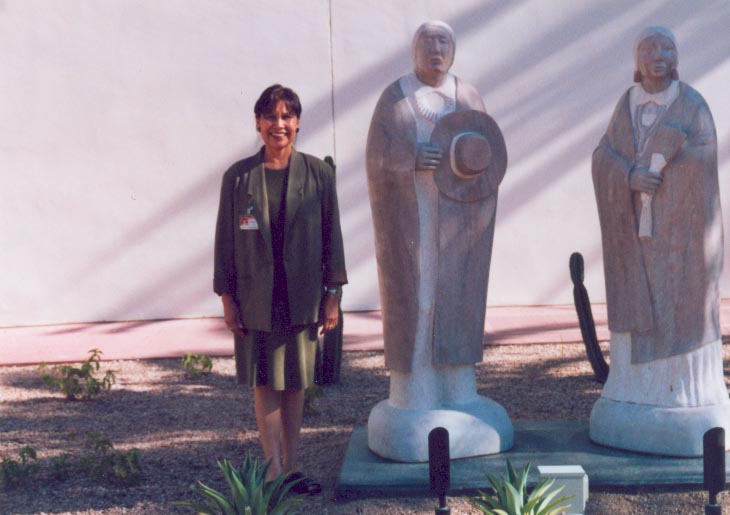
Particular sore points have included the consignment of Indians to natural history museums; the related notion that Indian cultures are relics of a vanished past; the grouping of diverse cultures under a single rubric, as well as other inaccurate representations; and the insensitive display of (often looted) human remains, funerary objects and artifacts designed for ceremonial use.
In part because of the 1990 Native American Graves and Repatriation Act (NAGPRA), the past decade has seen a revolution in museum practices. The repatriation of human remains, funerary objects, sacred and ceremonial objects, and objects of cultural patrimony in federally-funded institutions – all covered under the act – has proceeded deliberately. Meanwhile, the law has obliged museums to talk to tribal leaders and has led to collaborations that both sides praise.
Native Americans have entered mainstream museums as artists, performers, curators and educators, designing and enlivening traditional displays. They also have begun establishing tribal museums – most famously, the $193 million Mashantucket Pequot Museum and Research Center near Mystic, Conn.—in which they tell their stories without an intermediary. Given their paucity of authentic artifacts, the Pequots opted for an eclectic and often engaging mix of film, computers and vast, lifelike dioramas to describe their early history, cultural decimation and astonishing casino-fueled revival.
Elsewhere, however, old representations linger. At the Smithsonian’s National Museum of Natural History, for example, Alaskan and Canadian Natives are still called “Eskimos” – though a label now apologizes and explains that a planned reinstallation will recognize cultural diversity.
In general, museums in this country no longer display the bones of Native Americans (though many remain, unclaimed, in their collections). But ancient funerary objects – including highly prized Mimbres pottery—are on view even in such progressive places as the Museum of New Mexico’s Museum of Indian Arts and Culture (MIAC) in Santa Fe and the Heard Museum in Phoenix. Chavarria, curator of ceramics at the Santa Fe museum, said his suggestion that the pottery be taken off display was met with anger. “I got my head bit off, by curators and by donors,” he said. “My feeling was that this museum could fulfill its mission without displaying the grave goods of a child.”
Because of continuing suspicions towards museums, West said, some tribes have declined to cooperate even with the Indian-led NMAI. Joanna Osburn-Bigfeather, director of the Institute of American Indian Arts in Santa Fe, said that some Indians are wary not only of the Smithsonian label, but the fact that so many top officials at the museum – including key figures such as Bernstein and Volkert – are not Native American.
It’s worth noting that the increasing prominence of Native American concerns in the museum world – evident at this year’s meeting of the American Association of Museums in Baltimore – is not an isolated phenomenon. It coincides with an ongoing transformation of the idea of the museum and a continuing questioning of curatorial authority. No longer a temple where experts hand down sacred knowledge, the museum is now seen as a forum in which different voices, including those of traditional outsiders, contest history and culture.
The National Museum of the American Indian stands, however uneasily, at the intersection of these changes. The museum sponsored a 1995 symposium (now a book) called The Changing Presentation of the American Indian: Museums and Native Cultures, in which West calls the NMAI “more a hemispheric institution of living cultures than …a museum in the traditional sense.”
For models and antecedents, West said he looks west, to such places as the Museum of Indian Arts and Culture and the Heard Museum. He also cites lessons learned at the Heye Center. West hired Bernstein, MIAC’s director, after he had completed work on a 1997 exhibition on Southwest Indian tribes called “Here, Now and Always” – a title that affirms both Indian survival and land claims.
Thematically organized and eclectic in format, “Here, Now and Always” employed 16 credited curators (most of them Native) and incorporates dozens of individual voices, stories and memories. The show blurs chronology and distinctions among tribes – on purpose, said Bernstein: “Native people don’t have a time frame. That’s the idea… It was supposed to confuse you.”
But not one of the Heye Center’s inaugural exhibitions, “Creation’s Journey: Masterworks of Native American Identity and Belief,” is scheduled to come down. The 1994 show – which attacks the very notion of a “masterwork” as Western – sets Native interpretations of objects alongside anthropological and art-historical views. As a deconstruction of the interpretative process, the show’s premise was inspired, but the exhibition itself is cacophonous and muddled.
A second inaugural exhibition at the Heye Center, “All Roads Are Good: Native Voices of Life and Culture,” empowered individual curators to create mini-exhibitions from their favorite objects in the Heye Collection. The stunning artistry of the works, along with some clever displays, are pluses, but, again, visitors come away without any master narrative to help organize their impressions.
At the Heard Museum, the core exhibition, “Native American Peoples of the Southwest,” dating from the early 1980s, survived the museum’s recent renovation, but is described by the Heard’s new director, Frank H. Goodyear Jr., as “tired” and “dated.” An early effort by Ralph Appelbaum (who designed the core exhibition of the U.S. Holocaust Memorial Museum in Washington), it is organized geographically and by tribe, with a heavy anthropological emphasis. Its voluminous texts betray its age: No one in museums reads this much anymore.
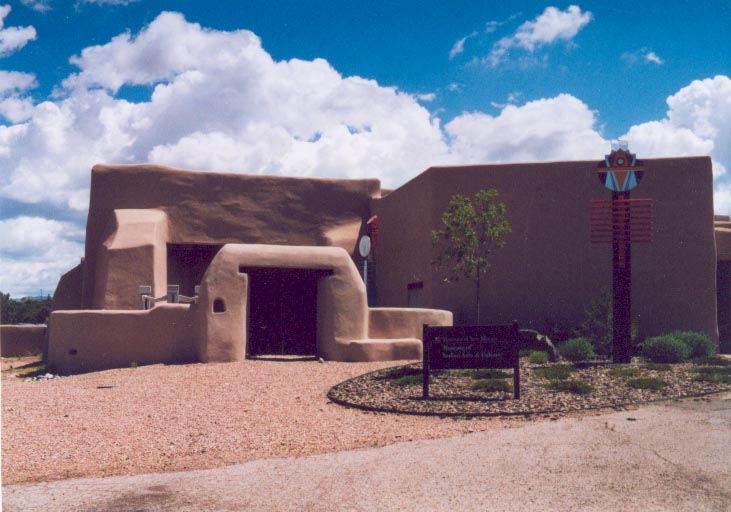
More recent Heard projects reflect the museum’s support of contemporary Indian artistic production and of Indian perspectives. “Rain: Native Expressions from the American Southwest,” a traveling show, tapped Native curators to explicate rain-related symbolism characteristic of different cultures. The museum’s orientation gallery, “More than Art,” explores the diverse meanings of Native artifacts for their creators, setting up an interpretative framework for the rest of the museum. “We Are! Arizona’s First People,” geared to a family audience, provides an interactive overview of how Arizona’s many Native communities see themselves.
Meanwhile, the Heard’s planning for a new core exhibition has begun. In addition to considerable Native involvement, live craftspeople and a thematic structure, Goodyear said he will also push for the inclusion of controversial points of view. As possible examples, he cites the book Man Corn: Cannibalism and Violence in the Prehistoric American Southwest, by Christy and Jacqueline Turner, and The Ecological Indian by Shepard Krech 3d, which attempts to complicate the stereotypical notion of the Indian in harmony with Nature. “I’m trying to inject a little bit of ‘Let’s tell both sides of the story’ attitude here,’” Goodyear said.
Goodyear questions whether the National Museum of the American Indian will do the same—in particular, whether a museum dependent on federal largesse will dare to criticize U.S. treatment of Indians. “I think Rick West has a problem on his hands,” Goodyear said. “The federal government was one of the major bad guys in the Indian story in this country. Is he going to tell that story? He can’t.”
West has a ready response. “We differ in a very important way from our distinguished sister institution, the national Holocaust museum,” he said. “We are not about a single moment in time, however important some of those moments are.” But, he added, “to the extent that we deal with that piece of time, I don’t expect to be anything less than direct about it.”
But there is more than one way to succumb to uncritical blandness. Take, for instance, the museum’s three-pronged statement of its educational objectives. The first idea, “Native Peoples are here today,” is at once unexceptionable and ideological. One could as well note that many Native peoples are not here today, and that in other cases – including the Pequot one – their language and cultural traditions have been largely lost.
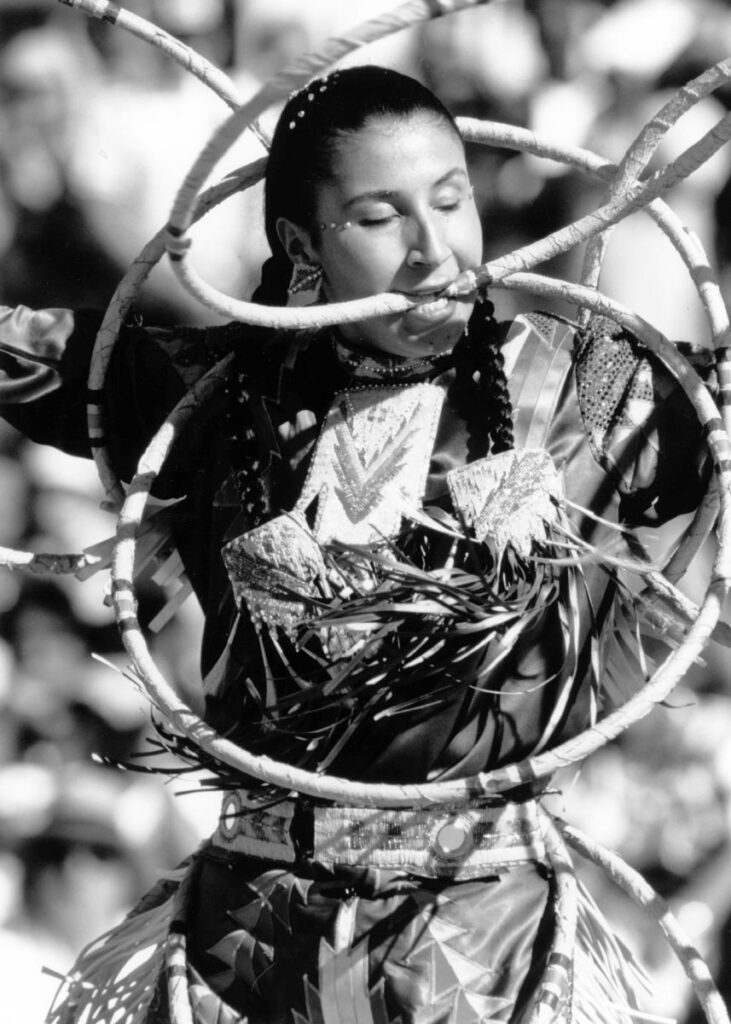
The museum’s other guiding notions, according to planning documents, are “Native Peoples are diverse but share some common beliefs and worldviews” and “The stories here are told by Native Peoples of the past and present because Native Peoples are the best teachers about their perspectives on history, art culture, beliefs and contemporary issues.” The first statement seems incontrovertible. The second appears to proscribe historical debate, especially if each tribe is limited to commenting on itself. (It might be more interesting, for example, to hear what the Pueblos have to say about Navajos and Apaches.) Bernstein talks about “multivocality,” but it’s hard to see how opposing or unflattering views will be expressed – at least within the exhibitions themselves.
“I think it is an important point of discussion whether the museum is celebratory or a memorial,” said Bernstein. “And I think that the decision of the museum at this point is…that it’s celebratory. It’s a place that tells of the triumphs of Native people, the survivals and sovereignties of Native people. Now, if you’re telling about the sovereignties and the triumphs, you’ve got to talk about some of the horrible things that have gone on, too—and perhaps some of the things that aren’t so pleasant going on in Native communities today.”
Embedded in that “perhaps” is the struggle the museum faces. Telling the complicated story of Indians in America – not just a triumph of survival or a tale of destruction and lingering despair, but both – will be hard to do. To manage it without deeply affronting either the museum’s Native American constituents or its mass audience will be harder still.
©2001 Julia Klein
Julia Klein, a Philadelphia writer and editor, is researching contested museums and memorials during her Patterson year.

